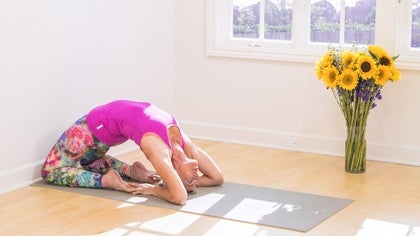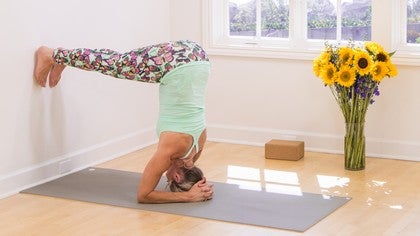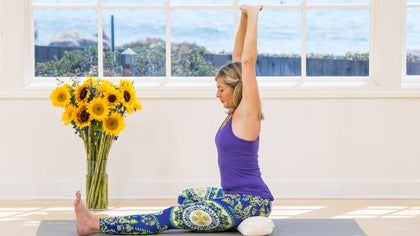Description
About This Video
Transcript
Read Full Transcript
(waves crashing) Namaste. So, let's look at the directions of growth that are possible within the posture. Once we've come into one of these postures, let's look at what we can do to explore it both externally and internally. First, we will look at one posture as an example and we'll use Janu Sirasana as an example for the variety of ways in which we can explore it externally and then we can begin to move in to what's going on inside the posture. The reason being, that if you look at the early texts, you will see that mantra, the recitation of mantra is used, repeating a word or a phrase is used while we're in the this shape.
We're observing our breath and then we're taking our mind and we're placing it at a very specific way. That's been lost in modern yoga, largely lost. So, let's look at what we can do with our mind so that indeed we can unite body, breath and mind within the practice. So let's begin. We'll take Janu Sirasana and what I suggest you do is take your left leg forward.
If you would, just bring the right foot in close so the sole of the foot comes to the inside of the thigh. You may find that you prefer to be up on a bolster and actually I will take the bolster or some sort of blanket or pillow, because we might be here just a little bit and it might be easier for your hamstrings. If your hamstrings are tight, you can go ahead and keep the knee bent, that will work. But I love this posture because it provides such a great example of what we can do. This posture itself if what I'm calling the seed posture, so we've come to a center point.
This is the first place to go within the posture. We usually know indeed we can go forward. We're going to look at some other options here. So from here, let's inhale, send the arms up and we'll interlace the fingers, turn the palms up. Let's get some space.
Go to in the torso, lifting the rib cage up, feeling the root, the dropping of the sit bones. And while we're here we can feel the drop of the sit bones soften the outside of the body. Just let the outside muscles relax a little bit. And if you close your eyes, it's easier to feel. Can you feel your awareness circulate through the body and where do you feel a lot of energy or sensation, where do you feel not so much sensation and attempt to take into account the whole body at the same time and then observe the breath.
Observe the body breathe and then just be here and inhabit the pose, fully inhabit the pose. And inhaling. Exhale, we'll fold forward now, we'll keep the root, come right in and either grasping the calf, the ankle, the foot, whatever's comfortable here, re-root, soften the outside, feel your awareness circulating the body, breathing and being in the posture. So we can coordinate this with the breath at this point, so we'll run through this once again. Slowly rise back up and let's switch sides.
Let's bring the left foot in and the right leg out and then open out. Good, be sure your sit bones are firmly rooted. Let's inhale. As you root down find your midline. That will happen naturally as you root.
Good, soften the outside of the body with the next breath. Feel your awareness all throughout the body, what you can and cannot feel, take note. You're being breathed. Watch the breath. Good, inhabit the posture, just being here.
We like to say be here now, be here now. And inhale, exhale, let's fold forward, pause. Now see if on your own you can remember those five cues. I might give you a hint, rooting, softening, spread your awareness, watch your breathing and fully be here. Good, now let's slowly rise up.
And send your left leg out, pause here. So what we've done now we've actually given our mind a place to go and no matter what the posture is, we can go through this process. It's an extremely thorough process and it means that we're setting up the shape so that we can then fill the shape with the yoga. I think it's exciting. So we've got the Asana, wonderful, the shape, and then we're going in.
So, from here we're going back out for a moment. We'll go right back to Janu Sirasana actually right foot to inside of left thigh. We'll come into the posture five breaths. See if you can remember those five cues and then we'll explore the outer dimensions of the posture from there. So, inhaling.
Exhaling. (breathing) And then we slowly rise up, interlace once again. Now where can this go? So we went forward, but we can also take it to the side. Just draw the right sit bone back a little bit.
Root both sit bones, inhale, exhale, keeping the root, let's extend over to the side. You go where you can go, so left hand could come down. We slowly make our way in and we remember the root, the softening, feel the whole body, just notice the rotation of the rib cage. Feel the breath, should move unimpeded throughout the body and notice we are here. Now inhale, slowly come right back up, exhale releasing.
So we went to the right, now obviously let's see will it go to the left, so this is what we're asking ourselves. Can it go to the right, uh-huh. Can it go to the left, indeed it can. Let's take the left arm around the back. Good, reroot.
Send the sit bones back, lengthen the spine, soften, enliven, observe the breath and be here now. Good, slowly come right back up. So then we ask ourselves where can this go? Well, in fact this can go back. This offers us a really nice counter pose.
Point the toes, inhale, rising up. Now feel the hand and foot root, the right chin root. Soften. Grow from the inside out. Feel the body breathe.
And be here. Inhaling, exhaling, let's release. Ah, lovely. Okay, so what this does is it means then if we're going to be practicing every day, we're not going down the same road, in this case, the same chain of hamstring right here. We're moving and we're alternating where the body is opening and I've found over time that that's a really good idea to create variety of experience in the body.
So let's try the other side. And this time I will be quiet. We can move together. See if you can remember those five points. So we'll turn to the left, interlace, come all the way up.
(breathing) Good, slowly rising, coming out. Now let's try the other side. Turn back forward. Right arm comes around the left, left arm could come to the foot or the calf. Don't worry about the forward fold, let's have it be a twist.
Good and then releasing, good, and counter pose, take the left hand back, let's rise up. (breathing) Inhale, rise back up, exhale, slowly release. Good, send your left leg out. So I especially love that fifth instruction, the one about being here now because what I find is that I often will spend so much time fixing what's going on inside that I don't actually experience the moment and when I give myself that room to experience the moment, there's a relaxation that comes over me that's just lovely. So what we've done now is we've explored the directions of Janu Sirasana, and Janu Sirasana especially offers us a complete, you know it's like sitting in the middle of a compass and we're moving around forward side, side, back.
Some postures will do that quite easily and it's worth finding out. So sometimes we'll think oh, my gosh, a particular system has said we can only do it this way. What I found is that it's really worth exploring. This is our practice. Find out for yourself.
Sometimes some of the postures can only go in two or three directions. But investigate it fully. Investigate it fully. What we'll do now is we're going to begin to go inside Janu Sirasana into what's called Maha Mudra. It's a very old Mudra, the whole body is in this Mudra and a teacher that I have great respect for Rama Swami, who studied directly with Krishna Macharia, he's now in his late 70s and he talks about the fact that as his practice has progressed, this posture's become more and more important.
It's a posture that he does every day. And let's try it shall we. So, we'll come right back Janu Sirasana. So we'll go ahead, bring the right foot in. Now here again actually you may very well want to have the sit bones up on something.
So, let's just do that now. And again, if the knee is bent, that's okay. It might be nice to have some support under the knee if that's the case. So, this is tricky to show you and if you're new to breath work, watch, absolutely watch and get a hang of it and start slowly, okay? So I'm going to inhale, send the arms all the way up and exhale.
I'll fold forward once again grasping what's here. Now, I'm going to root the sit bones downward. And what's important that I do is I begin to watch my breath. I'm going to take you step by step here. And I want to lengthen the breath as much as can, without causing any sort of stress to my body.
Now I'm going to come to the bottom of the breath and I'm going to pause, comfortably pause and then inhale. And exhale. Comfortably pausing, relaxing the belly and then inhale. And exhale. And in time my exhalations will become a little bit longer, but there's just no force or effort here.
Okay, so slowly inhale, rise up. Now switch sides and we're going to do it slightly different on this side. So if you are unfamiliar the bandas, I know that there's a number of videos at any time that can explain them. I explain them in one of mine as well. If they're brand new, it might be worth doing a little bit of work first.
Essentially I want to take the pelvic floor and I want to lift it up. And I am going to contract a little bit, the anal sphincter, the muscles down low, contract and lift. And I'm going to do that at the end of exhalation, so we did it just very lightly on this side without any sort of engagement. I will inhale and let's exhale fold. Grasp what you can here, then lengthen the spine root.
Exhaling. Now drawing the pelvic floor up, relax your belly, inhale. Exhale. The pelvic floor is going to draw up at the end of the exhalation and the naval draws into the spine. Relax your belly first, inhale.
Exhale. Relax the belly, inhale. Exhale. Keep the breath all the way out, draw the naval to the spine, pelvic spine lifts. Relax your belly, inhale.
Now move at your own pace. We'll do three more of these at our own pace. Pelvic floor lifts, naval to spine. Draw your chest to your chin a little bit. We're creating a seal.
And one more. (breathing) When you're ready, inhale, slowly rise up. Exhale, let's pause and sit for a moment to feel the effects, of that practice internally. Good. So I found out about myself, I'm somebody that even though I'm very idealistic, I tend to be a pragmatist and I really do tend to teach practices that I have felt make a difference.
This is a posture and a practice that I'm exploring and what I'm finding is that there's less mind chatter after I've practiced it and there's more integration. I feel more connected to my lower body after I've practiced it. Where the idea is that we're sealing and containing this space, which is really interesting and there's a lot of esoteric explanations, all of which are very fascinating, but I definitely am looking for what's going on in here for me and I'm hoping that you're asking yourself the same question, what's this like for me? So, as we move inward, we now are really playing with the inside of the shape. There are other ways to do that and I mentioned early on, mantra is one of them.
There are Sanskrit mantras, there poly mantras Om mani padmi hum is a great example of a mantra that can be used. You may, however, prefer to work with a mantra from the English language and I will offer us this mantra, today, the words thank you. It could be any word. It could be that you are a Christian and there is parts of the Lord's Prayer that you can recite. I know, for me, I really like thank you because I can automatically feel in my body the effect of saying those words.
So other than when you take those shapes, you take the postures and you come in and you cue those five, that's one way I'll practice often, those five little cues, but the other might be I fill the posture with a word and thank you's always useful, especially when I'm challenged by situations in my life that I'm feeling as though I'm coming up against. What I want to be able to do because we're headed to open awareness is just include whatever's there. So let's try this. Let's come into a seated position. Again, if you'd like to have a bolster, please take it.
Notice if you like the hands up or down. Root, soften, feel the inner body, feel the breath. Be right here. And then with each exhalation, just find yourself saying to yourself thank you. Thank you.
Thank you. Thank you. Thank you. Thank you. Thank you.
Let's bring your problems together in Anjali Mudra. It's a short bow and open the eyes. So that was a very mini meditation, but I'm hoping in that short time what you saw was there's the word and on your exhalation you say the word, whatever it is and then you notice the sensations that arise, you notice the thoughts that come up. Sometimes I'll think all of sudden I'll have people or scenarios that I am thankful for, they just arise. Sometimes it'll be the opposite, things that I've been struggling with and then I'm saying to myself, no include, let's include, we're going for including all of it because my reaction is not who I am.
Okay, so I hope that practice is useful. I've one more to give you and this is a practice that I do every day, every day because this is my personal practice I'm going to share with you. So what I'm working on is feeling this area of my body all the time and sometimes I'm very successful and sometimes I have to really to my practice and so what we'll do here is the reason we want to feel this, right, because it's one thing to be here now and the next step is to be able to be able to be a loving, open human being at all times. I know at the end of my life, I want to look back and say, yes, we did make some head way in that area. So this is why I practice.
We close the eyes and this is how it will go. Again, we root and we soften. Feel the inner body. Feel ourselves being breathed. Be right here and then we move our attention and our awareness down toward the heart in the center of the body.
And we notice first what do we feel down there. I notice for most of us we're very busy upstairs in the mind, making up stories, interpretation. We're attempting to reside down lower. Notice everything that's there and often what I find is what is in the way of feeling my heart. For example, there may be some resentment or some anger, sometimes some dullness.
I can't feel. Sometimes some sadness. But I'm looking at all this like I'm lying down in a field on my back at night looking up at the stars. No star is more important than any other. These are all thoughts and sensations and emotions, phenomenon that arise and pass and it's my work to be attentive and open to all of it.
And in that process of being attentive and open and fully able to feel, there it is. There's my heart. So if you get stuck along the way, just notice where you get stuck and hang out right there next to whatever that thing is that's difficult to penetrate. Just hang out, sit with it. Sit with it.
That's asana. And get to know it like a friend. A long lost friend. We sit down beside all of it and we love it all. Now let's draw the palms together at the heart and we bow to the heart and we open our eyes.
So don't you think that's a really worthy practice? I think the practice is important and it's something I'm willing to devote the rest of my life to. So, I hope you gain great value from it and all of these practices and use them in your own practice. Let's bring our hands to our forehead, right thought. May we be steady and present and joyful.
Let's bring to our mouth, right speech. May our words improve upon the silence. We bring our hands to our heart, right action. May we be the change that we wish to see. Namaste.
Mandala Yoga
Comments

You need to be a subscriber to post a comment.
Please Log In or Create an Account to start your free trial.













